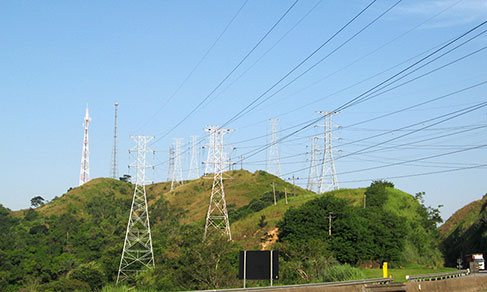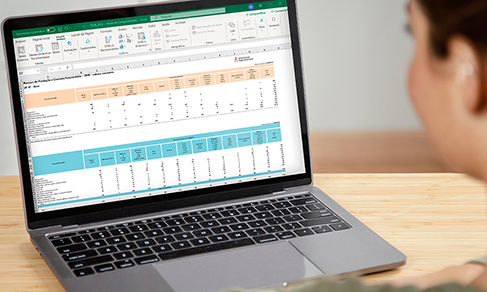Nossos serviços estão apresentando instabilidade no momento. Algumas informações podem não estar disponíveis.
SCN - System of National Accounts
About - 2023 System of National Accounts: Brazil
The System of National Accounts - SCN presents information on the generation, distribution and use of income in Brazil. There is also data on the accumulation of assets, financial assets and relations between the national economy and the rest of the world.
With this publication, the IBGE publishes the results of the System of National Accounts - reference 2010 corresponding to 2023, covering the Tables of Resources and Uses, the Integrated Economic Accounts, and the Synoptic Tables for the period from 2000 to 2023. The Tables of Resources and Uses show the flows of supply and demand of goods and services and also the generation of income and employment in each economic activity. The Integrated Economic Accounts, the central core of the System, offer a vision of the economy as a whole, describing, for each institutional sector, its essential phenomena – production, consumption, accumulation and assets – and their interrelations. The Synoptic Tables, in turn, bring together the main quantities calculated in the National Accounts System and allow identifying, for each year of the period considered, the following indicators: the Gross Domestic Product - GDP; the composition of aggregate supply and demand; the generation, distribution and use of national income; capital accumulation; the ability or need for financing; current transactions with the rest of the world; per capita income; the evolution of the tax burden; and the disaggregation of the public and private sectors, for some aggregates, among other information about the Brazilian economy.
The technical notes enclosed in this release can be also accessed on this page, which also brings the complete methodology of the SNA, as well as notes, organized by themes, in which their component charts are presented, as well as details of the changes caused by the implementation of the time series with reference to 2010.
It should be highlighted that the information of the time series of the System of National Accounts - reference 2010 is presented according to the National Classification of Economic Activities (CNAE 2.0) and are in accordance with the System of National Accounts 2008 (SNA 2008), a manual produced by the United Nations, European Commission - Eurostat, International Monetary Fund (IMF), Organization for the Economic Cooperation and Development (OECD) and World Bank, which reflects the IBGE commitment to periodically revise its practices according to the international recommendations.
Important note
As a result of the additional work to redesign the SNA, whose reference year will change from 2010 to 2021, the results of this edition of the study are presented in a unusual format, without analytical commentaries. It should also be noted that the requirement to carry out this redesign project leads to the definition of a transition period in which the publication of the more detailed time series is temporarily suspended. Therefore, the results now available do not include the details provided by the Tables of Resources and Uses and Integrated Economic Accounts published annually. However, the most aggregated estimates are maintained, calculated using the current methodology and published with special emphasis on their preliminary nature, based on the System of Quarterly National Accounts - SCNT, which includes the Tables of Resources and Uses for 12 activities and 12 products and the Integrated Economic Accounts for the aggregate national economy.
Tables - 2023 System of National Accounts: Brazil
Synoptic tables
Table 1 - Overview of the economic picture, worldwide and national, according to the major indicators - 2000-2023 ( xls | ods )
Table 2 - National economy - Goods and services account - 2000-2023 ( xls | ods )
Table 5 - Components of the Gross Domestic Product under the three views, current and constant values and variation of volume, price and value - 2000-2023 ( xls | ods )
Table 6 - Gross Domestic Product, Per capita Gross Domestic Product, resident population and deflator - 1996-2023 ( xls | ods )
Table 7 - Gross fixed capital formation, current and constant values and investment rate - 1995-2023 ( xls | ods )
Table 9 - Change in volume of the gross value added, according to groups of activities - 2011-2023 ( xls | ods )
Table 10.1 - Constant and current gross value added, according to groups of activities - 2000-2023 ( xls | ods )
Table 11.1 - Change in volume of the gross value added at basic prices, according to groups of activities - 2001-2023 ( xls | ods )
Table 12.1 - Change in prices of the gross value added at basic prices, according to groups of activities - 2001-2023 ( xls | ods )
Table 13.1 - Share in the gross value added at basic prices, according to groups of activity - 2000-2023 ( xls | ods )
Supply and use tables
Table 1 - Supply of goods and services - 2023 ( xls | ods )
Table 2 - Uses of goods and services - 2023 ( xls | ods )
Table 3 - Supply of goods and services - 2023 ( xls | ods )
Table 4 - Uses of goods and services - 2023 ( xls | ods )
SUT Summary - 2023 ( xls | ods )
GDP growth in cumulative volume between two years - Brazil - 1947-2022 ( xls | ods )
Table Summary ( pdf )
The IBGE adopts a review policy of the data disclosed by this statistical operation. Data review means any and all scheduled revision of numerical data due to new information, which was not accessible at the time of the first disclosure. For instance: late data that replaces a non-response; or data corrected by the informant himself; or a set of data that has undergone editing and imputation. For more detailed information about the published data review policy of the IBGE statistical operations, check the list of short-term, long-term and special surveys carried out by the Institute with their respective revision procedure on: https://biblioteca.ibge.gov.br/index.php/biblioteca-catalogo?view=detalhes&id=298009.
Concepts and methods - 2023 System of National Accounts: Brazil
As informações a seguir descrevem os metadados estatísticos, que são o conjunto de conceitos, métodos e aspectos relacionados às estatísticas, e são informações necessárias para compreender as características e a qualidade das estatísticas e interpretá-las corretamente.
Informações Gerais
Objetivo
Ser o sistema síntese para dados estatísticos relacionados a economia nacionalTipo de operação estatística
Sistema de contas nacionaisTipo de dados
Dados agregadosPeriodicidade de divulgação
AnualMetodologia
Informações sobre os métodos utilizados no SCN estão disponíveis em https://www.ibge.gov.br/estatisticas/economicas/contas-nacionais/9052-sistema-de-contas-nacionais-brasil.html?=&t=notas-tecnicas
Técnica de coleta:
Não se aplicaProcedimento de amostragem
não se aplica a sistemas sínteseCrítica e imputação
não se aplicaTemas
Temas e subtemas
Estatísticas macroeconômicasPrincipais variáveis
Produto Interno Bruto - PIB, PIB per capita, Produção, Consumo Intermediário, Valor Adicionado Bruto, Despesa de Consumo Final, Formação Bruta de Capital Fixo - FBCF, Renda Nacional Bruta, Renda Nacional Disponível Bruta, Poupança Bruta, Capacidade/Necessidade Líquida de FinanciamentoPalavras-chave
PIB, PIB per capita, Crescimento, Produção, Consumo Intermediário, Valor Adicionado Bruto, Consumo Final, FBCF, Investimento, Renda Nacional Bruta, Renda Nacional Disponível Bruta, PoupançaUnidades de informação
Unidade de investigação
Não se aplicaUnidade de análise
Família, Empresa, Unidade local, ProdutoUnidade informante
Não se aplica.Períodos de referência
Disseminação
Formas de disseminação
Banco de Dados Agregados - SIDRA, Publicação Digital (online)Nível de desagregação geográfica
NacionalNível de divulgação
Tabelas sinóticas com 12 atividades (detalhamento do PIB trimestral) Tabelas de Recursos e Usos com 12 atividades x 12 produtos Obs: o detalhamento da publicação foi ajustado a partir da publicação SCN 2022 devido a necessidade de alocação das equipes no projeto de mudança de base/nova série do SCNHistórico
Saiba mais
https://metadados.ibge.gov.br/consulta/estatisticos/operacoes-estatisticas/SUPublications - 2023 System of National Accounts: Brazil
Sistema de Contas Nacionais : Brasil : 2023 : notas técnicas / IBGE, Coordenação de Contas Nacionais
Material type: Book
Year: 2025
Description
The System of National Accounts presents information about the generation, distribution and use of income in Brazil. It also contains data about the accumulation of non-financial assets, financial assets and about the relationship between national economy and the rest of the world. With the release of this publication, the IBGE brings into view the System of National Accounts - reference 2010, including data related to 2014 and, on an exceptional basis, the review of some results of the series from 2010 to 2013, whose changes, due to methodological adjustments among other factors, are detailed in a specific topic.
The Supply and Use Table presents the results at current prices and at prices in effect in the previous year. It shows the flows of supply and demand of goods and services and also the generation of income and employment in each economic activity. The Integrated Economic Accounts, in the core of the system, provide and overall view of the economy, describing the essential phenomena for each institutional sector – production, consumption, accumulation and assets – and their interrelations in the period of time considered. The synoptic tables gather the main variables calculated in the System of National Accounts and allow the identification, for each year, of the Gross Domestic Product - GDP; composition of aggregated supply and demand; generation, distribution and use of the national income; accumulation of capital; net lending or borrowing; current transactions with the rest of the world; per capita income; evolution of the tax burden; disaggregation of non-financial enterprises per origin of capital, private and public; and the disaggregation of the public and private sectors, for some aggregates, among other information of the Brazilian economy.
This publication also highlights the time series of the GDP growth rates for the 1951-2014 period. At the end, a glossary registers the terms and concepts considered relevant.
The information on the System of National Accounts - reference 2010 series is presented according to a new classification of products and activities, integrated with the National Classification of Economic Activities - CNAE 2.0.
All these results, including the complete series of the SNA since 2000, is available at the IBGE web portal. The web portal also provides information on the methodological criteria adopted in the new series, produced in accordance with the System of National Accounts 2008 - SNA 2008 manual, reflecting the commitment of the IBGE with the periodic reviews of the System of National Accounts as determined by the international recommendations.
Technical Information
Technical and methodological notes
Methodological Reports Series
- System of National Accounts - 3rd edition
- System of National Accounts - 2nd edition
- System of National Accounts - 1st edition
Methodological notes - reference 2010
Methodological notes of the new series of the System of National Accounts (SNA) - reference 2010
News and Releases
GDP grows 3.2% and adds up to R$10.9 trillion in 2023
HIGHLIGHTS In 2023, the Gross Domestic Product (GDP) reached R$10.9 trillion, a growth of 3.2% compared...
06/11/2025
With increases in industry and services, GDP grows by 1.4% in Q2
In the second quarter of 2024, the Gross Domestic Product (GDP) of the country increased by 1.4% against...
03/09/2024
GDP grows by 4.8% and reaches R$ 9 trillion in 2021
At a glance Brazil’s Gross Domestic Product - GDP hit R$ 9 trillion in 2021, a rise of 4.8% from 2020....
08/11/2023
GDP changes -0.2% in Q4, closes 2022 at 2.9%
The Brazilian Gross Domestic Product (GDP) changed -0.2% in the fourth quarter of 2022 and closed the...
02/03/2023
With services affected by pandemic, GDP of 2020 falls 3.3%
In 2020, when the COVID-19 pandemic impacted the world economy, the Brazilian Gross Domestic Product...
04/11/2022
Cooperation between IBGE and Federal Revenue details supply and demand in Federation Units
The IBGE releases today (3), the Tables of Resources and Uses by Federation Units (2018). The tables...
03/08/2022
GDP increases by 4.6% in 2021 and closes the year at R$8.7 trillion
The Gross Domestic Product - GDP rose 4.6% in 2021 from 2020. Industry (4.5%) and Services (4.7%) recorded...
04/03/2022
GDP grows by 4.6% in 2021 and makes up for pandemic losses
The Brazilian Gross Domestic Product (GDP) grew by 0.5% in Q4 2021 and closed the year at 4.6% of increase,...
04/03/2022
IBGE advances in the use of fiscal information for statistical production
The IBGE launches today the Tables of Resources and Uses by Federation Unit: Matrices of the 2018 production...
29/10/2021
GDP increases 1.8%, reaches R$7.0 trillion in 2018
The Gross Domestic Product - GDP hit R$7.0 trillion in 2018, a rise of 1.8% over 2017. The per capita...
06/11/2020
Errata
Updating of tables of System of National Accounts: Brazil 2020
Published date: 16/03/2023
Description:
Amendment of Synoptic Tables 16, 16.1, 16.2, 16.3 and 17, Table of the Integrated Intermediate Accounts (CEI), Table Economic accounts at current prices, according to accounts, transactions and balances.Actions: The related tables have been amended and replaced on the Portal.
File replacement in System of National Accounts 2020
Published date: 30/11/2022
Description:
Error noticed in the release of the System of National Accounts 2020. Files related to "Integrated economic accounts" and "Economic accounts, at current prices, according to accounts, transactions and balances" were not released in their final version, thus requiring a replacement.Actions: The files were replaced and an updating note was included on the results page of the survey, on the IBGE Portal.
Error in the release "GDP changes 0.4% in Q2 2019", disclosed in the IBGE website and in the IBGE News Agency
Published date: 29/08/2019
Description:
The table containing the main GDP results at market prices in the text had data from Q3 2015 to Q3 2016.
Actions: Table replaced, data inserted: main GDP results at market prices from the Q2 2018 to Q2 2019.Replacement of the "Tables of resources and uses - Levels 12 and 51" of the System of National Accounts of Brazil
Published date: 12/12/2016
Description: Errors in the value of production of the activity Domestic services 2001 at current prices in the Table of Resources and Uses.
Actions: Files corrected and replaced on the IBGE website.
Replacement of tables of resources and uses of the System of National Accounts - Brazil 2010-2013 - reference 2010
Published date: 26/11/2015
Description: Replacement of tables of resource and use.
Actions: Files amended and replaced and update note included in the page giving access to the files.
Replacement of retropolated synoptic tables of the System of National Accounts - Brazil 2010-2013 - reference 2010
Published date: 24/11/2015
Description: Replacement of retropolated synoptic tables.
Actions: Files amended and replaced and update note included in the page giving access to the files.
Replacement of synoptic tables of National Accounts Brazil 2010-2011
Published date: 21/05/2015
Description: Amendment in "Compensation of non-residents, Property income, Other current transfers and Capital transfers, sent to and received from the rest of the world, in the synoptic table 2 - National Economy - Capital, income and production account"
Actions: Files amended and replaced. Update note included in the page giving access to the files.
Replacement of the Complete Publication of National Accounts Brazil 2010-2011
Published date: 21/05/2015
Description: Amendment in "Compensation of non-residents, Property income, Other current transfers and Capital transfers, sent to and received from the rest of the world, in the synoptic table 2 - National Economy - Capital, income and production account"
Actions: File amended and replaced. Update note included in the page giving access to the file. Errata included in the publication.
Change in the tables of the System of National Accounts - Brazil 2010-2011 - reference 2010
Published date: 22/04/2015
Description: Amendment in table 2 of the Tables of Resources and Uses, in the Value Added spreadsheet, in current values level 12, 20, 68 activities in the Summary TRUs and CEI 2011 (CD and Internet). Failure in formatting table 4 - Components of the Gross Domestic Product under the three viewpoints, constant and current values and change in volume, price and value, related to the indication of the measurement unit. The measurement unit indicated was R$1,000 rather than R$1,000,000.
Actions: Files amended and replaced. Update note included in the page giving access to the file. Errata included in the Publication.












